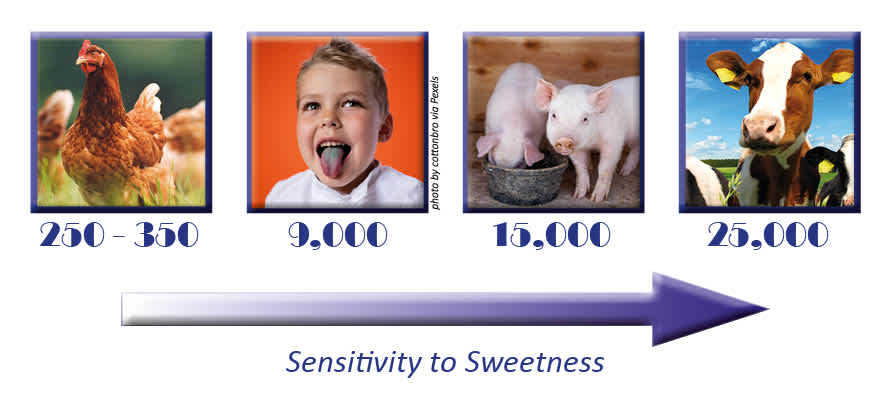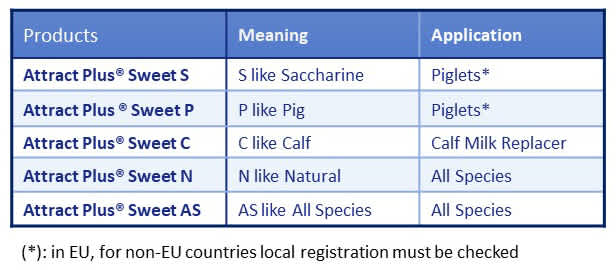Attract Plus® Sweet: Increase ration flexibility without compromising feed intake

How to increase palatability?
Palatability is the pleasant sensation associated with ingested food or drink, and can be decreased when using alternative feed ingredients or medication. Aromas, flavors and sweeteners are all tools that can be used to increase feed palatability.
An aroma is a combination of volatile substances that has a pleasant smell. In contrast, a flavor has an impact on both taste and smell. A sweetener does not have a smell, and is detected by specific taste buds on the tongue that generate a sensation of sweetness. This article will specifically focus on sweeteners.
What is the value of sweeteners?
Sweeteners play a central role in terms of encouraging feed intake, particularly during stress and dietary transition (i.e., weaning or changes in feed composition). This is due to the positive reinforcement experience of the sweetness sensation when the feed is ingested.
Bitter tasting feed ingredients and medication decrease feed palatability, which negatively impacts feed intake. Sweeteners can mask these bitter tastes, which makes them a valuable tool to increase flexibility with ration formulation without compromising feed intake.
Pigs and ruminants have a much more physiologically developed sense of taste compared to poultry. This is clearly evidenced by their higher number of taste buds, which are also greater than that of humans (Figure 1). This means that pigs and ruminants, unlike poultry, are very receptive to the sensation of sweetness and benefit most from the inclusion of sweeteners in feed.

Figure 1: Sensitivity to sweetness is underpinned by the number of taste buds
Types of sweeteners
Sweeteners can be broadly divided into two groups:
Natural sweeteners based on ingredients such as stevia, thaumatin and liquorice extracts.
Artificial sweeteners that are mainly formulated using saccharine and neohesperidin dihydrochalcone (NHDC).
Combinations of different sweeteners also exist, allowing sweetener product concepts to be developed that have a high sweetener index at a reasonable cost level.
Currently within the EU, there is no limitation on the use sweeteners other than saccharine and NHDC. Saccharine is only permitted for use in piglets up to 16 weeks of age (max of 150ppm in finished feed). In contrast, NHDC (max of 35 ppm in finished feed) is permitted for a much wider range of animals: piglets, fattening pigs, calves, sheep, fish and dogs.
For non-EU countries local legislation needs to be checked, however, the use of both natural and artificial sweeteners is in general widely permitted in most animal species.
When to use sweeteners?
Sweeteners can be used under any circumstance. Examples of situations where inclusion of sweeteners are particularly valuable are as follows:
Piglets at weaning: Sweeteners can improve palatability and stimulate starter feed intake which can help to reduce a post weaning dip in feed intake.
Calf milk replacer: Replacement of milk protein with vegetable protein can have a negative impact on palatability that can be compensated for by use of sweeteners.
Dairy cows: Feed is used to encourage cows to enter milking systems. Using a sweetener in the feed gives the animal an additional positive reinforcement/reward for using the system.
Lower palatability feed ingredients: Formulating rations with available raw ingredients or more cost-effective by-products that have poorer palatability can be compensated for by using a sweetener. This enables the global feed cost to be decreased whilst using feed materials that are more readily available.
Palital’s Attract-Plus® Sweet range offers a range of different sweetener concepts (Table 1) that can be effectively used in these and other situations to improve feed palatability.

Table 1: Palital’s Attract-Plus® Sweet product range
In conclusion, in the current economic situation of the livestock industry it should not be overlooked that sweeteners are a way to reduce feed cost while maintaining feed efficiency. Attract-Plus® Sweet is a key tool to enable increased feed reformulation flexibility in order to optimize ration cost, as well as allowing animals to cope with feed transition and stress.